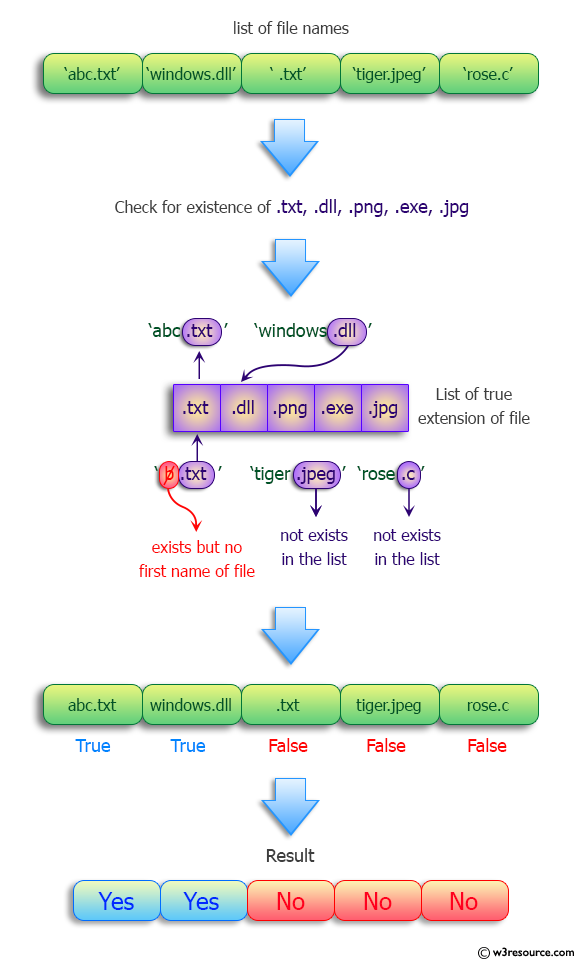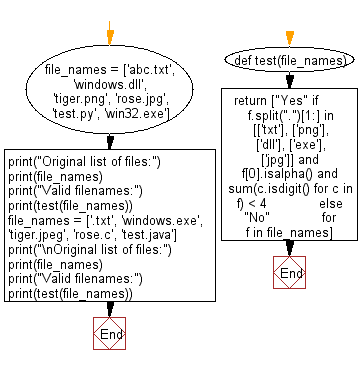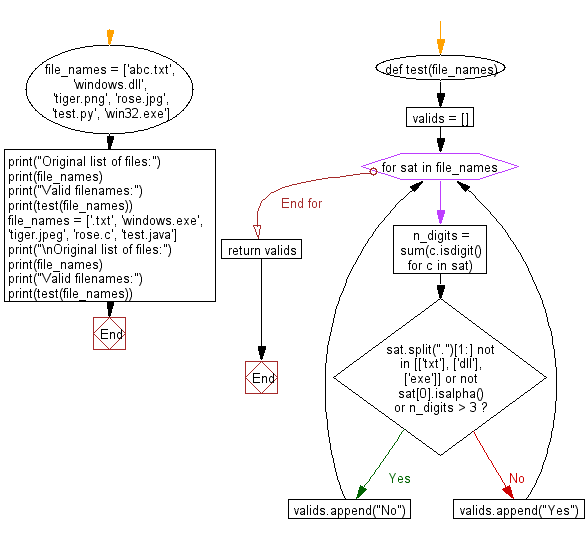Python: A valid filename
Python Programming Puzzles: Exercise-59 with Solution
A valid filename should end in .txt, .exe, .jpg, .png, or .dll, and should have at most three digits, no additional periods. Write a Python program to create a list of True/False that determine whether candidate filename is valid or not.
Input: ['abc.txt', 'windows.dll', 'tiger.png', 'rose.jpg', 'test.py', 'win32.exe'] Output: ['Yes', 'Yes', 'Yes', 'Yes', 'No', 'Yes'] Input: ['.txt', 'windows.exe', 'tiger.jpeg', 'rose.c', 'test.java'] Output: ['No', 'Yes', 'No', 'No', 'No']
Pictorial Presentation:

Sample Solution-1:
Python Code:
def test(file_names):
return ["Yes" if
f.split(".")[1:] in [['txt'], ['png'], ['dll'], ['exe'], ['jpg']] and f[0].isalpha() and sum(c.isdigit() for c in f) < 4
else "No"
for f in file_names]
file_names = ['abc.txt', 'windows.dll', 'tiger.png', 'rose.jpg', 'test.py', 'win32.exe']
print("Original list of files:")
print(file_names)
print("Valid filenames:")
print(test(file_names))
file_names = ['.txt', 'windows.exe', 'tiger.jpeg', 'rose.c', 'test.java']
print("\nOriginal list of files:")
print(file_names)
print("Valid filenames:")
print(test(file_names))
Sample Output:
Original list of files: ['abc.txt', 'windows.dll', 'tiger.png', 'rose.jpg', 'test.py', 'win32.exe'] Valid filenames: ['Yes', 'Yes', 'Yes', 'Yes', 'No', 'Yes'] Original list of files: ['.txt', 'windows.exe', 'tiger.jpeg', 'rose.c', 'test.java'] Valid filenames: ['No', 'Yes', 'No', 'No', 'No']
Flowchart:

Visualize Python code execution:
The following tool visualize what the computer is doing step-by-step as it executes the said program:
Sample Solution-2:
Python Code:
#License: https://bit.ly/3oLErEI
def test(file_names):
valids = []
for sat in file_names:
n_digits = sum(c.isdigit() for c in sat)
if sat.split(".")[1:] not in [['txt'], ['dll'], ['exe']] or not sat[0].isalpha() or n_digits > 3:
valids.append("No")
else:
valids.append("Yes")
return valids
file_names = ['abc.txt', 'windows.dll', 'tiger.png', 'rose.jpg', 'test.py', 'win32.exe']
print("Original list of files:")
print(file_names)
print("Valid filenames:")
print(test(file_names))
file_names = ['.txt', 'windows.exe', 'tiger.jpeg', 'rose.c', 'test.java']
print("\nOriginal list of files:")
print(file_names)
print("Valid filenames:")
print(test(file_names))
Sample Output:
Original list of files: ['abc.txt', 'windows.dll', 'tiger.png', 'rose.jpg', 'test.py', 'win32.exe'] Valid filenames: ['Yes', 'Yes', 'No', 'No', 'No', 'Yes'] Original list of files: ['.txt', 'windows.exe', 'tiger.jpeg', 'rose.c', 'test.java'] Valid filenames: ['No', 'Yes', 'No', 'No', 'No']
Flowchart:

Visualize Python code execution:
The following tool visualize what the computer is doing step-by-step as it executes the said program:
Python Code Editor :
Have another way to solve this solution? Contribute your code (and comments) through Disqus.
Previous: Biggest even number between two numbers inclusive.
Next: Find numbers that are adjacent to a prime number in the list, sorted without duplicates.
What is the difficulty level of this exercise?
Test your Programming skills with w3resource's quiz.
Python: Tips of the Day
Find current directory and file's directory:
To get the full path to the directory a Python file is contained in, write this in that file:
import os dir_path = os.path.dirname(os.path.realpath(__file__))
(Note that the incantation above won't work if you've already used os.chdir() to change your current working directory, since the value of the __file__ constant is relative to the current working directory and is not changed by an os.chdir() call.)
To get the current working directory use
import os cwd = os.getcwd()
Documentation references for the modules, constants and functions used above:
- The os and os.path modules.
- The __file__ constant
- os.path.realpath(path) (returns "the canonical path of the specified filename, eliminating any symbolic links encountered in the path")
- os.path.dirname(path) (returns "the directory name of pathname path")
- os.getcwd() (returns "a string representing the current working directory")
- os.chdir(path) ("change the current working directory to path")
Ref: https://bit.ly/3fy0R6m
- New Content published on w3resource:
- HTML-CSS Practical: Exercises, Practice, Solution
- Java Regular Expression: Exercises, Practice, Solution
- Scala Programming Exercises, Practice, Solution
- Python Itertools exercises
- Python Numpy exercises
- Python GeoPy Package exercises
- Python Pandas exercises
- Python nltk exercises
- Python BeautifulSoup exercises
- Form Template
- Composer - PHP Package Manager
- PHPUnit - PHP Testing
- Laravel - PHP Framework
- Angular - JavaScript Framework
- Vue - JavaScript Framework
- Jest - JavaScript Testing Framework
